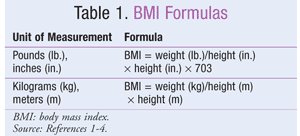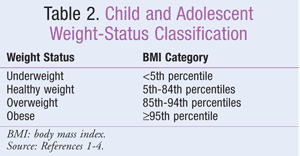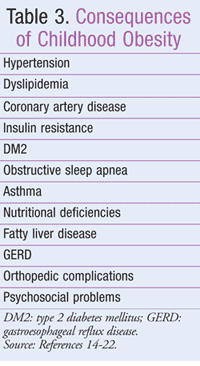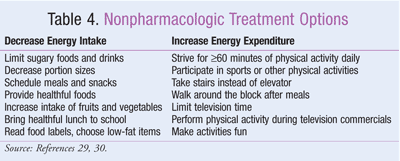US Pharm. 2011;36(3):28-32.
The last several decades have seen a significant increase in the incidence of childhood obesity. This increase, which is considered an epidemic by many experts, represents a major public health concern. Childhood obesity is associated with numerous medical, psychosocial, and economic consequences that continue into adulthood. Multiple factors have led to this dramatic increase, most of them revolving around patients having a positive energy balance worsened by an increasingly sedentary lifestyle. Multiple treatment approaches are required to address these causes.
Definitions of Obesity
Body mass index (BMI)—a measure of weight in relation to height—is a screening tool used to assess body fat. BMI has become the preferred method for defining overweight and obesity in children and adolescents because it is noninvasive, easily obtained, and strongly correlated with total body fat.1,2 See TABLE 1 for available BMI formulas and TABLE 2 for a classification of weight status.


For patients aged 2 through 19 years, weight status may be determined by plotting the BMI value on the CDC 2000 growth charts, which results in an age- and gender-specific percentile.3,4 In contrast to the adult classification of obesity—which is based on a numerical BMI cutoff—age- and gender-specific percentiles are used for pediatric patients, since body composition differs for boys and girls and for children and adolescents as they grow. Overweight is defined as a BMI at or above the 85th percentile on the CDC 2000 growth charts for children of the same age and gender; this replaces the previously used term “at risk of overweight.”3,4 Obesity is considered a BMI at or above the 95th percentile or a BMI greater than 30 kg/m2, whichever is smaller; this definition replaces the term “overweight.”3-5 Unfortunately, even with these definitions, many overweight and obese children and adolescents may remain underdiagnosed.6
Prevalence
The prevalence of childhood overweight and obesity represents a serious health concern. The increasing rate of obesity in adults and children has been described as the “obesity epidemic.”7 The 2007–2008 National Health and Nutrition Examination Survey reported that almost 17% of children and adolescents aged 2 to 19 years are obese, representing more than 12.5 million children and adolescents in the United States.5 Obesity rates for children and adolescents aged 2 to 19 years have more than tripled during the last 3 decades.5
Disparities in the risk of obesity exist between racial and ethnic groups and according to socioeconomic status. In 2007–2008, the obesity rate was 26.8% for Mexican-American adolescent boys, compared with 16.7% for non-Hispanic white adolescent boys.5 For girls in 2007–2008, the obesity rate was 29.2% for non-Hispanic black adolescents and 14.5% for non-Hispanic white adolescents.5 A recent European study found that children of low socioeconomic status had a statistically significant increase in obesity rates, whereas children of middle and high socioeconomic status had no changes in rates.8
Risk Factors
Risk factors associated with childhood obesity include a combination of genetic and environmental factors. Genetic studies investigating an obesity gene and other hormones that increase physiologic risks of obesity are being conducted; however, the majority of studies are examining environmental and behavioral patterns.3,9,10 Children are spending more time playing video games, using the computer, and watching television, all of which are associated with decreased physical activity. Greater consumption of energy-dense snacks and sweetened beverages, larger portion sizes, and increased involvement in sedentary activities lead to an imbalance between energy intake and expenditure, thereby contributing to obesity.2,7
Consequences
The consequences of obesity in adults have been well documented.11 Obese adults have greater health risks that encompass most bodily systems. With the recent increase in obesity in children and adolescents, more health consequences are occurring in this population (TABLE 3). A longitudinal study concluded that obese adolescents are significantly more likely than their normal-weight counterparts to become obese adults.12

Epidemiologic studies have found a strong link between obesity and the development of hypertension, whether in childhood or adulthood.13 Dyslipidemia—most commonly, high triglycerides and low HDL—occurs in obese children and adolescents.14 Observational studies have concluded that childhood and adolescent obesity is linked to an increased risk of developing coronary artery disease in adulthood.15
A known effect of obesity on the endocrine system is insulin resistance, which may lead to type 2 diabetes mellitus (DM2).11 Childhood obesity has led to a documented rise in circulating insulin levels and a reduction in insulin sensitivity, possibly contributing to the development of DM2.16 The increased prevalence of childhood and adolescent obesity has been accompanied by a rise in DM2 incidence in this population.16
Additional consequences of pediatric obesity include obstructive sleep apnea, asthma, left ventricular diastolic dysfunction, gastroesophageal reflux disease, vitamin D deficiency, and orthopedic disorders.14,17-20
Childhood obesity may cause psychosocial problems. Patients often experience a significantly poorer health-related quality of life than their normal-weight counterparts, and social stigmatization can cause stress and low self-esteem.21 Low self-esteem may result in poorer academic performance and compromised social functioning.22
Obesity also has economic consequences. Obesity-associated costs may be as high as $147 billion per year, and likely will continue to rise with the increasing prevalence of childhood obesity.23
Prevention
Prevention is the most widely recommended approach to curbing the obesity epidemic in the U.S.3,11 Children and adolescents may be good candidates for preventive measures. Although prevention is a commonly accepted approach, evidence for an effective method is lacking. Obesity prevention can likely be achieved through decreased caloric intake (food) and increased energy expenditure (exercise and activity). Although this may be a good starting point, measures should be carried out at various levels, starting with the patient and expanding to health care providers and the community.3,11
Parents should encourage healthful food choices and reasonable portion sizes. Family members should also help the patient increase the amount of physical activity and activities of daily living, as well as minimize sedentary activities.24 School-based interventions have shown some promise for helping prevent obesity in children and adolescents. Most school-based interventions involve lowering the caloric content of school-provided meals and increasing physical activity.25 Other obesity-prevention efforts targeting the community include public policies like the Let’s Move! initiative and organizational campaigns like the National Football League’s Play 60 program.26,27
The medical setting presents an ideal opportunity for intervention when a trend toward obesity is identified. Infants and children visit medical settings frequently for well-child checks and acute-care needs. During these visits, providers can track weight and height and may notice when a deviation occurs that could indicate progression to obesity. Providers can make BMI screening a standard of care for each clinic visit, thus affording opportunities to counsel patients, caregivers, and families about the risks of obesity and strategies for preventing obesity, when required.
Nonpharmacologic Treatment Options
One goal of treatment is improved body weight and body composition. Secondary goals include improvements in obesity-related comorbidities and metabolic abnormalities, increased physical fitness and endurance, and better family functioning and self-esteem.28,29
All overweight and obese adolescents should have a weight-management plan.28 Such plans should focus on righting the balance between energy intake and expenditure. To achieve overall weight loss, patients must reduce caloric intake while also increasing physical activity.
No specific intervention is recommended for all patients. TABLE 4 contains suggested recommendations.29,30 Dietary recommendations include initiating a low-fat diet with greater fruit and vegetable consumption and limiting or eliminating sugary foods. Daily scheduling of predefined meals and snacks may help reduce energy intake by restricting the amount of food eaten between meals. A gradual reduction in portion size will restrict daily intake, as will the institution of healthier snacks. Other recommendations for reducing total calories include avoiding sweetened drinks, limiting the use of fats in food preparation, selecting low-fat products, and bringing a healthful lunch to school.29,30

Many patients will not achieve weight loss by caloric restriction alone; increased energy expenditure is required in most cases.29,30 Sedentary activities such as television, computer, and video games should be limited. Physical activities that are tailored to individual fitness levels should be implemented. It is important to encourage peer and family involvement in physical activity, and special care should be taken not to embarrass the child to whom physical activity does not come easily.
Pharmacologic Treatment Options
Pharmacotherapeutic agents should be used only if significant, severe comorbidities exist and only after intensive lifestyle modifications have failed. A strong family history of DM2 or cardiovascular (CV) risk factors may strengthen the case for pharmacotherapy.29 Weight-loss agents have a long and complicated history. Many medications have been introduced, only to be withdrawn because of increased adverse effects (AEs). Fenfluramine, ephedra, phenylpropanolamine, and sibutramine have been removed from the market because of CV concerns. The use of weight-loss agents must be evaluated on an individual basis, with particular stringency in children since long-term effects are unknown.
Sibutramine (Meridia), an FDA-approved medication for obesity treatment in patients aged 16 years and older, was withdrawn in October 2010 because clinical data demonstrated increased risks of heart attack and stroke.31 This leaves orlistat (Xenical) as the only FDA-approved treatment for childhood obesity.
Orlistat blocks the absorption of fat in the intestine by inhibiting lipase activity. This prevents the digestion of approximately 30% of the fat consumed.32 Orlistat is approved for patients aged 12 years and older at a dose of 120 mg three times daily. AEs include flatus, abdominal cramping, fecal incontinence, steatorrhea, gallstones, and possible fat-soluble vitamin malabsorption.32-34 A multicenter, 12-month, double-blind trial randomized 539 obese subjects aged 12 to 16 years to orlistat 120 mg or placebo three times daily and provided general lifestyle guidelines.33 Mean BMI decreased with orlistat (–0.55 kg/m2), but increased with placebo (+0.31 kg/m2). Another study randomized patients to orlistat 120 mg or placebo three times daily for 6 months in addition to lifestyle recommendations.34 The 6-month change in BMI (–1.3 kg/m2 in the orlistat group vs. –0.8 kg/m2 in the placebo group) was not significant.
Metformin, a biguanide, improves insulin sensitivity while reducing intestinal glucose absorption, decreasing hepatic glucose production, and increasing peripheral glucose uptake. It is approved for use in patients aged 10 years and older for treatment of DM2 only; it is not approved to treat obesity. Usual dosing in adolescents is 250 mg to 1,000 mg twice daily. AEs include nausea, bloating, flatulence, diarrhea, and possible lactic acidosis. A randomized, double-blind, crossover trial compared metformin 1,000 mg twice daily with placebo in 28 obese subjects aged 9 to 18 years.35 Compared with placebo, metformin produced statistically significant reductions in weight (–4.35 kg), BMI (–1.26 kg/m2), waist circumference, and abdominal adipose tissue. Other trials have shown similar results.36-38
Other agents are being studied, mostly for adult obesity. These drugs include recombinant human leptin, topiramate, zonisamide, exenatide, liraglutide, bupropion, and naltrexone. It is unknown whether any of these products will be approved for weight loss or if they could be used to treat childhood obesity.
Bariatric Surgery
Severely obese pediatric patients who have failed attempts at weight loss may be assessed for possible bariatric surgery. The International Pediatric Endosurgery Group has developed guidelines for surgical treatment of severe obesity.39 Candidates must have a BMI greater than 40 and have serious obesity-related comorbidities. They should have nearly attained adult stature, must avoid pregnancy for at least 1 year, and must be capable of adhering to proper nutritional management following surgery.
Conclusion
Identifying and actively intervening to prevent childhood overweight and obesity is necessary, since this epidemic is unlikely to improve on its own. Obesity is a serious public-health concern with consequences that extend into adulthood. The lack of pharmacotherapeutic options reinforces the importance of nonpharmacologic interventions that emphasize restoring energy balance to a state of decreased intake and increased physical activity.
REFERENCES
1. Himes JH. Challenges of accurately measuring and using BMI and other indicators of obesity in children. Pediatrics. 2009;124:S3-S22.
2. Krebs NF, Himes JH, Jacobson D, et al. Assessment of child and adolescent overweight and obesity. Pediatrics. 2007;120:S193-S228.
3. Barlow SE and the Expert Committee. Expert Committee recommendations regarding the prevention, assessment, and treatment of child and adolescent overweight and obesity: summary report. Pediatrics. 2007;120:S164-S192.
4. CDC. About BMI for children and teens. www.cdc.gov/healthyweight/
5. Ogden C, Carroll M. Prevalence of obesity among children and adolescents: United States, trends 1963-1965 through 2007-2008. CDC. www.cdc.gov/nchs/data/hestat/
6. Benson L, Baer HJ, Kaelber DC. Trends in the diagnosis of overweight and obesity in children and adolescents: 1999-2007. Pediatrics. 2009;123:e153-e158.
7. Biro FM, Wien M. Childhood obesity and adult morbidities. Am J Clin Nutr. 2010;91:1499S-1505S.
8. Stamatakis E, Wardle J, Cole TJ. Childhood obesity and overweight prevalence trends in England: evidence for growing socioeconomic disparities. Int J Obes (Lond). 2010;34:41-47.
9. Maes HH, Neale MC, Eaves LJ. Genetic and environmental factors in relative body weight and human adiposity. Behav Genet. 1997;27:325-351.
10. Gale SM, Castracane VD, Mantzoros CS. Energy homeostasis, obesity and eating disorders: recent advances in endocrinology. J Nutr. 2004;134:295-298.
11. National Institutes of Health with National Heart, Lung, and Blood Institute. Clinical Guidelines on the Identification, Evaluation, and Treatment of Overweight and Obesity in Adults. Bethesda, MD: National Institutes of Health; September 1998. NIH pub. no. 98-4083.
12. The NS, Suchindran C, North KE, et al. Association of adolescent obesity with risk of severe obesity in adulthood. JAMA. 2010;304:2042-2047.
13. Sorof J, Daniels S. Obesity hypertension in children: a problem of epidemic proportions. Hypertension. 2002;40:441-447.
14. Daniels SR. Complications of obesity in children and adolescents. Int J Obes (Lond).
15. Owen CG, Whincup PH, Orfei L, et al. Is body mass index before middle age related to coronary heart disease risk in later life? Evidence from observational studies. Int J Obes (Lond). 2009;33:866-877.
16. Steinberger J, Moran A, Hong CP, et al. Adiposity in childhood predicts obesity and insulin resistance in young adulthood. J Pediatr. 2001;138:469-473.
17. Amin RS, Kimball TR, Bean JA, et al. Left ventricular hypertrophy and abnormal ventricular geometry in children and adolescents with obstructive sleep apnea. Am J Respir Crit Care Med.
18. Gilliland FD, Berhane K, Islam T, et al. Obesity and the risk of newly diagnosed asthma in school-age children. Am J Epidemiol. 2003;158:406-415.
19. Alemzadeh R, Kichler J, Babar G, Calhoun M. Hypovitaminosis D in obese children and adolescents: relationship with adiposity, insulin sensitivity, ethnicity, and season. Metabolism. 2008;57:183-191.
20. Nead KG, Halterman JS, Kaczorowski JM, et al. Overweight children and adolescents: a risk group for iron deficiency. Pediatrics. 2004;114:104-108.
21. Schwimmer JB, Burwinkle TM, Varni JW. Health-related quality of life of severely obese children and adolescents. JAMA. 2003;289:1813-1819.
22. Schwartz MB, Puhl R. Childhood obesity: a societal problem to solve. Obes Rev. 2003;4:57-71.
23. Finkelstein EA, Trogdon JG, Cohen JW, Dietz W. Annual medical spending attributable to obesity: payer-and-service-specific estimates. Health Aff (Millwood). 2009;28:w822-w831.
24. Sherburne Hawkins S, Cole TJ, Law C. An ecological systems approach to examining risk factors for early childhood overweight: findings from the UK Millennium Cohort Study. J Epidemiol Community Health. 2009;63:147-155.
25. Davis MM, Gance-Cleveland B, Hassink S, et al. Recommendations for prevention of childhood obesity. Pediatrics. 2007;120:S229-S253.
26. Let’s Move! www.letsmove.gov. Accessed January 29, 2011.
27. NFLRUSH Play 60. www.nflrush.com/play60. Accessed January 29, 2011.
28. Steinbeck K. Childhood obesity. Treatment options. Best Pract Res Clin Endocrinol Metab. 2005;19:455-469.
29. August GP, Caprio S, Fennoy I, et al. Prevention and treatment of pediatric obesity: an Endocrine Society clinical practice guideline based on expert opinion. J Clin Endocrinol Metab. 2008;93:4576-4599.
30. Speiser PW, Rudolf MC, Anhalt H, et al. Childhood obesity. J Clin Endocrinol Metab. 2005;90:1871-1887.
31. James WP, Caterson ID, Coutinho W, et al. Effect of sibutramine on cardiovascular outcomes in overweight and obese subjects. N Engl J Med. 2010;363:905-917.
32. Kirk S, Scott BJ, Daniels SR. Pediatric obesity epidemic: treatment options. J Am Diet Assoc. 2005;105:S44-S51.
33. Chanoine JP, Hampl S, Jensen C, et al. Effect of orlistat on weight and body composition in obese adolescents: a randomized controlled trial. JAMA. 2005;293:2873-2883.
34. Maahs D, de Serna DG, Kolotkin RL, et al. Randomized, double-blind, placebo-controlled trial of orlistat for weight loss in adolescents. Endocr Pract. 2006;12:18-28.
35. Srinivasan S, Ambler GR, Baur LA, et al. Randomized, controlled trial of metformin for obesity and insulin resistance in children and adolescents: improvement in body composition and fasting insulin. J Clin Endocrinol Metab. 2006;91:2074-2080.
36. Kay JP, Alemzadeh R, Langley G, et al. Beneficial effects of metformin in normoglycemic morbidly obese adolescents. Metabolism. 2001;50:1457-1461.
37. Fu JF, Liang L, Zou CC, et al. Prevalence of the metabolic syndrome in Zhejiang Chinese obese children and adolescents and the effect of metformin combined with lifestyle intervention. Int J Obes (Lond). 2007;31:15-22.
38. Clarson CL, Mahmud FH, Baker JE, et al. Metformin in combination with structured lifestyle intervention improved body mass index in obese adolescents, but did not improve insulin resistance. Endocrine. 2009;36:141-146.
39. International Pediatric Endosurgery Group. Guidelines for surgical treatment of clinically severely obese adolescents. www.ipeg.org/education/ 2009;33:S60-S65. 2002;165:1395-1399.
To comment on this article, contact rdavidson@uspharmacist.com.





